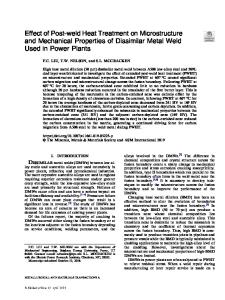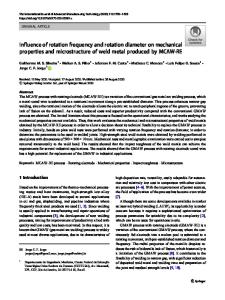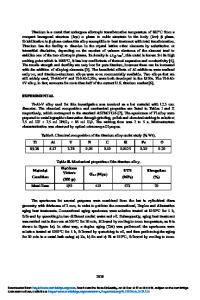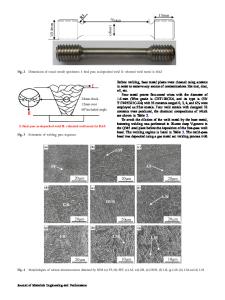Effect of Post-Weld Aging Temperature on Microstructure and Mechanical Properties of Weld Metal of 15-5 PH Stainless Ste
- PDF / 2,499,618 Bytes
- 8 Pages / 593.972 x 792 pts Page_size
- 24 Downloads / 386 Views
JMEPEG https://doi.org/10.1007/s11665-020-05193-y
Effect of Post-Weld Aging Temperature on Microstructure and Mechanical Properties of Weld Metal of 15-5 PH Stainless Steel Jingpeng Niu, Bing Cui
, Huijin Jin, Jialing Yan, Wei Meng, Chunying Min, and Dong Xu
(Submitted March 9, 2020; in revised form September 7, 2020; Accepted September 19, 2020) This study is an attempt to correlate the microstructure and mechanical properties of weld metal of commercial 15Cr-5Ni precipitation-hardening stainless steel at different post-weld treatments. The weld metal is conducted by gas tungsten arc welding, and post-weld aging is performed at three different temperatures, viz. 580 °C, 600 °C and 620 °C. After post-weld aging treatment, the microstructure and mechanical properties of weld metals are investigated by OM, SEM, EDS, EBSD and impact tester. The results indicate that microstructure of weld metals by post-weld aging treatment consists predominately of martensite, reversion austenite and copper-rich phase. The amount of austenite and the size of copper-rich phase increase with increase in the post-weld aging temperature. The tensile strength of weld metals first increases and then decreases with the increasing of post-weld aging temperature. The former is due to the size and distribution of copper-rich phase, and the latter is due to the increasing of amount of reversion austenite. Keywords
copper-rich phase, mechanical properties, post-weld aging temperature, reversion austenite, weld metal
1. Introduction Precipitation-hardened stainless steel is a new type of steel developed during the second world war due to the need of war and then gradually developed into three types: martensite type, semi-austenitic type and austenitic type. They are mostly in Cr, Ni and then adding precipitation hardening stainless steel elements such as Al, Cu, Ti, Mo and Nb through hightemperature solid solution treatment, make the alloy elements can dissolve into the matrix and supersaturated solid solution after cooling, and then in the appropriate temperature aging treatment, decomposition of supersaturated solid solution, intermetallic compounds, carbide precipitation, such as dispersion precipitate hardening effect, and this kind of steel heat treatment is simpler, such as the 15-5PH stainless steel has good corrosion resistance, high strength and good processing properties. A simple one-step aging treatment gives the 15-5PH high strength and good plasticity and toughness, which is widely used in key components in the aerospace field (Ref 1-7). Aging treatment is the main strengthening method of martensitic precipitation hardening stainless steel. High strength and Jingpeng Niu, Bing Cui, Wei Meng, Chunying Min, and Dong Xu, Anhui Province Key Laboratory of Metallurgy Engineering and Resources Recycling (Anhui University of Technology), MaÕanshan 243002, China; Huijin Jin, State Key Laboratory of Nonlinear Mechanics, Institute of Mechanics, Chinese Academy of Sciences, Beijing 100190, China; and Jialing Yan, East China Electric Power Te
Data Loading...











